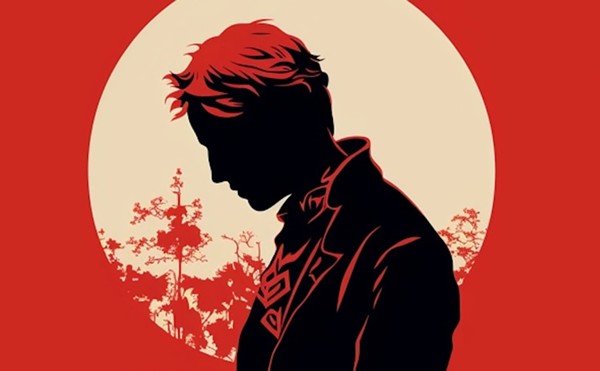By Jim Jacobs and Warren Casey
The Muny
Grease is a comic valentine to doo-wop days, an affectionate parody of the music, manners and modes of high-school students in the late '50s. Created as an intimate show with no chorus or big production numbers, Grease hands at least one song to each of the 10 buddies in the gang at the center of the show.
You might wonder what such a small musical was doing last week on the vast reaches of the Muny stage in front of 11,000 people. The temptation to blow it up with flashing lights, glitzy costumes and thousands of extras must have been nearly irresistible. That's what happened to the Grease that Tommy Tune produced on Broadway a few years ago and that has played the Fox a couple of times, and it was a disaster. The show's tacky charm got lost in the flash and dazzle.
Fortunately, director Mitzi Hamilton and choreographer Thommie Walsh rejected that temptation, giving us a Grease with an even more intimate feel than the Muny's last staging of the show. Yes, they did use the Muny's song-and-dance chorus of a dozen-and-a-half local performers, plus a "teen ensemble" of more than twice that many. But they used them judiciously and sparingly -- in the dance in the school gym, for instance, and in a guy's fantasy celebration of his junkyard heap, "Greased Lightnin'." The rest of the time they kept the focus clearly and properly on those 10 buddies, played by performers cast not because they were household names but because they could do the acting, singing and dancing that the show requires. That's been one of the happy directions in which Paul Blake has taken the Muny in his tenure -- hiring people who are good at musical theater even if they don't have a big hit on TV -- and it's paid off in the quality of productions and the size of audiences.
Blake has also made a practice of using local actors in supporting roles. We got little of that in Grease -- but you could argue that the supporting roles are more than supporting roles in this show. James Anthony did a smooth turn as the slightly sleazy disk jockey Vince Fontaine, showing visiting star Marilyn Sokol, who played English teacher Miss Lynch, how to do the adults in Grease. Sokol gave us an endless flow of tired shtick, picked up, I guess, when she was doing the same role in the Broadway production. Gretchen Bieber stepped out of the chorus to dazzle as the prize-winning dancer at the prom. I guess we can no longer claim Ken Page as a local actor, though he started his career on the Muny stage, but he proved again, in the double roles of crooner Johnny Casino and the Teen Angel, that he can fill and thrill the huge Muny space like few other performers. This Grease was good summer fun.
THE SOUND OF MUSIC
By Richard Rodgers, Oscar Hammerstein II, Howard Lindsay and Russell Crouse
St. Charles Repertory Theatre Company and Lindenwood University
Lindenwood University is following the path trod by Southern Illinois University-Edwardsville in its summer-theater productions by opening casting to the community, combining students with older and more experienced actors as well as some who have not yet entered college. This can yield above-average performances, but it also can make the range of abilities present on the stage, from best to worst, more obvious than that in a strictly campus production.
Such a spread showed up recently in Rodgers and Hammerstein's The Sound of Music. At the top stood a winning performance of Maria by Tina Scoggins. But even the lesser talents had been well rehearsed by Marsha Parker, who directed clearly and simply, and by music director Joyce Von Dielingen. The cast's confidence kept the production alive even when the pace of acting or singing dragged. Rob Scoggins' choreography made a few basic steps charming. But the very high platform that dominated Doug Russell's set called attention to itself in a way that made everything about it seem artificial.
I do feel that some paradigm of the decline of American culture can be traced in the descent of Rodgers' music from the dry wit of Pal Joey to the saccharine "Climb Every Mountain."
LOVE LETTERS
By A.R. Gurney
St. Louis Community College-Florissant Valley
How amusingly and affectionately A.R. Gurney depicts the tribal rites of the WASP elite of the northeastern U.S., and how gently he -- and their trust funds -- ease them through the foibles and failures in their lives. The bittersweet Love Letters presents two members of the tribe in the simplest of forms, the letters they wrote each other throughout their lives. He, who rises through prep school and the Ivy League to the Navy, the law and, finally, the U.S. Senate, feels most comfortable expressing himself in writing. She, even wealthier than he, follows her mother's self-destructive path of alcoholism and multiple marriages and gets impatient with the tedious task of putting her words on paper.
Two faculty members at Florissant Valley, Donna Spaulding and Jack Hake, brought this pair to vivid life last weekend while simply sitting at a table and reading their letters. He was the more restrained of the two, subtly shading his reticence through a slightly mannered style. Her responses, livelier and broader, put her feelings up front. You come to know both so intimately that, however much you may disapprove of some things they do, finally you share Gurney's affection forhem.





